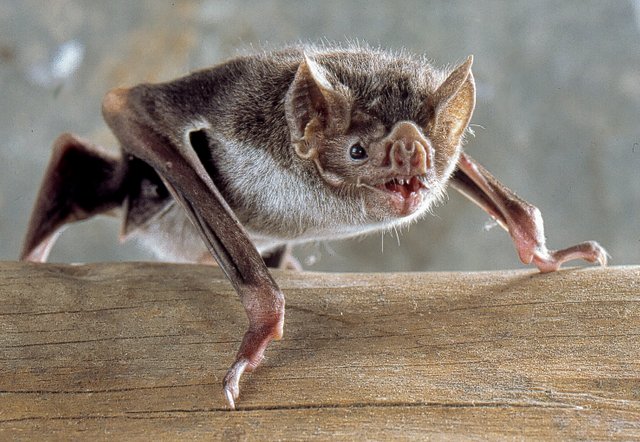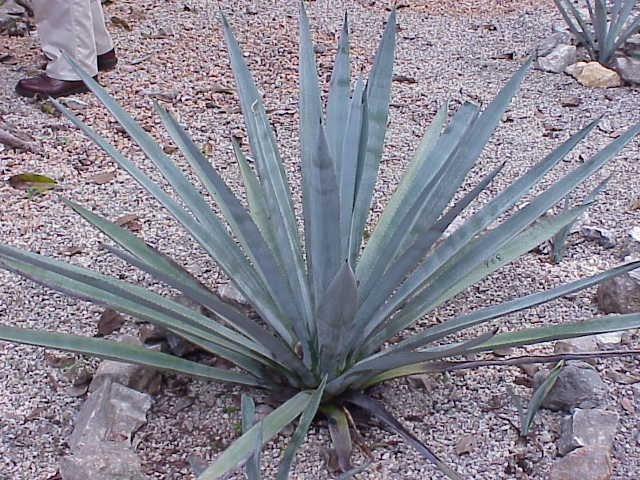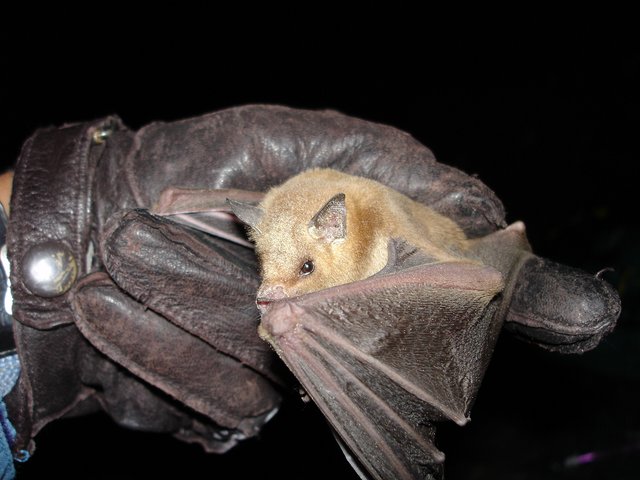Conservation success stories #2: The lesser long-nosed bat (Leptonycteris yerbabuenae) recently got removed from the US Endangered Species List because of great conservation efforts
The lesser long-nosed bat (Leptonycteris yerbabuenae) is a medium-sized bat that is mainly found in Mexico, but that can also seasonally migrate to the southern part of the United States. It is a type of bat that only eat nectar from plants, preferably night-blooming cacti such as Organ Pipe Cactus (Stenocereus thurberi) and the blue agave (Agave tequilana).
A lesser long-nosed bat. Image by US Department of Agriculture/Flickr; CC BY 2.0.
Like many other bats, they sleep in huge roosts at day, and fly out during the twilight to search for nectar all night long. It does not really affect humans all that much, except for spreading pollen for the blue agave plant, a plant that is needed if we want to make tequila. Basically it gets filled with pollen when eating the nectar, which ends up letting the blue agave spread to new locations.
How the lesser long-nosed bats became threatened
The number of lesser long-nosed bats were healthy until around the 1980s when they began to decline pretty rapidly. There were actually a few different reasons that we will look at, all which lead to their decline, and almost to their extinction.
Firstly, the caves and abandoned mine shafts that they used to roost in were suddenly invaded by people. Both human trafficking smugglers, as well as drug smugglers would use caves and old mine shafts while smuggling people and drugs from Mexico into the US. It’s obviously not easy to ask drug smugglers what they did to the bats, but it is believed that a great number of them died both directly from being killed by the humans who occupied the caves, as well as dying indirectly from the disruption they caused.
The second reason why the numbers of lesser long-longed bats declined during this time was because they were indirect casualties of the fight against vampire bats. The latter type of bat is responsible for carrying rabies which infected both cattle and humans, and many people actively destroyed bat roosts in order to prevent the vampire bats from being able to breed.

A vampire bat (Desmodus rotundus). Image by Uwe Schmidt, posted with the Creative Commons Attribution-Share Alike 4.0 International license.
The problem with destroying the roosts of vampire bats is that the lesser long-nosed bats also got a lot of roosts destroyed, even though these guys were no threat to humans at all. Most likely the roosts were mistakenly identified as a vampire bat roost.
The third and final big reason of their decline was changing practices in the tequila industry. Tequila was getting very popular at this time, and the companies who made tequila had to increase their production quickly. What they did might sound smart, but it was almost fatal for the bats.
Instead of letting the bats be responsible for pollinating the blue agave plant like they have always been, the farmers instead began to clone the plants. By doing this they could cut the agave before it even fully blossomed, and the bats lost their main source of food!

Blue agave, the plant needed to make tequila. Image by Kurt Stüber, posted with the Creative Commons Attribution-Share Alike 3.0 Unported license.
These three problems quickly decimated the bat population, and by 1988, there was estimated to be less than 1,000 lesser long-nosed bats alive in total, in only 14 different colonies.
The conservation efforts to save the lesser long-nosed bat
Luckily both conservation groups and the US government realized the threat that the bats were facing before it was too late, and they got added to the US Endangered Species List in 1988. The government teamed up with private organizations to help protect the remaining bats, while also studying their behavior and trying to figure out how they could save the species.

Image is Public Domain.
By putting radio transmitters to some of the bats, scientists were able to learn about their migratory patterns, and locate the roosts that were still active. These roosts then received “bat-gates” that would prevent other animals (including humans) from entering them, and thus leaving the bat to be able to sleep and reproduce without any disturbance.
Mexican tequila producers also did their part, of some brands even stopped cloning the plants, and instead want back to the old ways when the bats did the pollination. Some brands even made “bat-friendly tequila” that apparently became popular with certain buyers.
These two efforts worked out pretty good, and about 30 years later, both the US and the Mexican governments have removed the bats from their list of endangered species. It is believed to be around 200,000 lesser long-nosed bats alive, meaning that they have increased exponentially from the 1,000 that were alive in the early 1990s.
Thanks for reading
Most of my sources for this post is from the press release sent out by the U.S. Fish and Wildlife Service when this bat was removed from the US Endangered Species List, so check that out to learn more, or follow one of the links in the text above.
I hope you enjoyed the post, and remember to follow for more!
The «Conservation success stories» series
The Conservation success stories series focus on bringing the good news about conservation biology, where actions made by us humans have led to reintroductions, increasing population sizes, or stopped an extinction process. I believe that this series is very important because conservation biology is usually filled to the brim with bad news, so it is important to remember that some efforts actually do pay off.
Previous entries:
About @valth
Hey, I'm @valth - the author of this post. I love to write about nature, biology, animals, nature conservation, ecology and other related branches of science, and I occasionally write about my life, about Steem or about random stuff as well. I'm trying my best to write at least one post every day, so make sure to give me a follow if you enjoy my content and want to see more of it.
Join the @valth community!
I love nothing more than to engage with my readers, so please join the @valth community in the comment section. You will definitely find more information about the topic, personal experiences, questions, and even opposing views down there, so don't miss out on learning more.
I always reward users who post good comments, so please take the opportunity to share your views and get a small upvote in exchange for it.
This was good news @Valth. This shows that it helps with every effort we do to try to protect and help the wildlife that are in danger around the world.
Yeah, it's amazing to see that the conservation efforts actually pays off every once in a while.
sir, you provide us a massive knowledge about lesser long-nosed bats.
honestly sir i never read or heard about them before.i just only knows about normal bats usually we see in a night. sir, somewhere else i don't remember in a book or google don't know exactly i read that Vampire bats could soon swarm to the United States.As we all knows about the history of United States that Thousands of years ago, the United States was home to vampires. Fossils of multiple vampire bat species have been found in California, Texas, Florida, Arizona, and other states is this the reason behind?
Thanks. There are lots of different species of bats, so most people don't know which one is which :P
That's interesting, but unfortunately I don't know anything about it. Sorry!
I'm happy to see that solutions have been found,
so that long-nosed bats can live quietly again and repopulate!
In France and mainly in the south where I live, many species have been reduced, mainly because of pesticides used in agriculture ...
Here is the example for cherry trees, before was used a powerful product and toxic for the environment, to treat against the fly that lays in cherries.
This product is finally banned and since there are no other effective and non-harmful products,
today growers make nests for bats to put in their orchards,
because a scientific study was done on their excrement and we realized
about 30% were tree fly of cherry remnants!
Finally a step in the right direction for the return of this animal that I find so beautiful and so useful ...
Resteem thanks.
Thanks for the resteem! But you're right about the fact that there are lots of species, both animals and plants, that are seeing a big population decline these days. Luckily the effort to save the lesser long-nosed bats succeeded, but we need efforts like this for so many different species all over the world, so we still have a big job ahead of us!
Indeed, if a large part of the world could realize
the importance that each species has, we would make great progress.
So good to see how effective coordination and conservation translated into a marvelous success.
I mean from 1000 to 200,000 thats a great achievement by conservationists...
They deserve all the applauses and accolades..
Yeah, it's a huge achievement! I hope top see the number keep growing even higher though ;)
I love reading articles like this! It's great to know that there is plenty of hope left for humanity and that with teamwork we can save our wildlife from extinction.

Same here. There are so many depressing stories about how species become extinct, so it's great to see that it's the other way around for some species :)
I always prefer good news than bad ones. I guess it goes to everybody as well..
Hehe, yeah, I guess we all do.
You have great knowledge about species and this long nosed is also kind of weird bat. I have never seen these species live.
Thanks. I have not seen them in real life either, since they are only found in Mexico and sometimes in the US, which I have never been to.
Wow, its really nice to see the hard work of naturalists pay off. An overall edutaining post :)
Yeah, it's definitely good to see that the hard work is paying off in the end :)
I had no idea that this species existed, it is a bit strange I must admit but it is a living being and I am glad that it is no longer in danger of extinction! Great
Hehe, most people don't know that they exist :P But yeah, it's great news!
This is great, @valth i was posted about endangered species
Thanks. Oh, that's great! I'll make sure to check it out :)
Nice Capture all click...
Thanks.